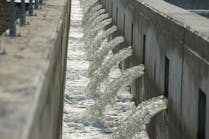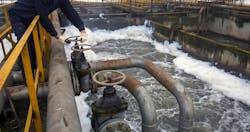Navigating the complexities of discharge regulations in industrial water/wastewater
The task of navigating the detailed and frequently updated regulations governing industrial water and wastewater discharge is a significant challenge for many businesses. With stringent federal acts, state-specific regulations, and additional industry and site-specific requirements, businesses must stay vigilant to remain compliant. To shed light on these complexities, we spoke with Peter Rundell, Business Development Manager and Environmental Testing expert at Microbac Laboratories. With a Bachelor of Science in Environmental Studies from the State University of New York College of Environmental Science and Forestry, Peter has extensive experience working directly with clients across the industrial water and wastewater industry. In this Q&A, he shares his insights on how companies can effectively navigate discharge regulations, keep up with changing standards, and ensure their operations meet all necessary compliance requirements.
Q: What are the most common challenges industries face when trying to comply with discharge regulations?
A: Wastewater discharge regulations are highly complex, with multiple federal acts, state-specific regulations and additional industry and site-specific regulations that must be considered. Therefore, adequate planning to navigate these regulations is essential to ensure compliance.
The U.S. Environmental Protection Agency (EPA) issues regulations for all wastewater discharged to surface waters and municipal sewage treatment plants through the National Pollutant Discharge Elimination System (NPDES) program, part of the federal Clean Water Act (CWA). Their regulations are based on the different categories of industry and the performance of treatment and control technologies. Note that most states apply to the EPA to run their own NPDES programs and become responsible for many permitting, administrative and enforcement activities. Additionally, some federally recognized tribes are authorized for Treatment as State (TAS) and have also applied to run their own programs. The states of Idaho, New Hampshire, Massachusetts, New Mexico, the District of Columbia, and most U.S. territories leave it under the sole responsibility of the EPA. The Safe Drinking Water Act (SDWA) is another EPA act that regulates all water potentially designed for drinking use and must also be considered in many instances. The CWA and the SDWA both determine the sampling and analysis methods that are to be used, and in some cases, there is jurisdictional overlap that must be considered.
To add further complexity, the CWA has numerous regulations within it that must also be considered in some industries and locations. For instance, the CWA requires industrial users to report any substance discharged to publicly owned treatment works that, if otherwise disposed of, would be considered a Resource Conservation and Recovery Act (RCRA) hazardous waste. The Toxic Substances Control Act (TSCA) must also be considered when managing current toxic substances, while the complimentary Comprehensive Environmental Response, Compensation, and Liability Act (CERCLA), also known as Superfund, focuses on the cleanup of inactive hazardous waste sites where there are toxic substances from historical activities.
Due to these diverse industry-specific and site-specific regulations, the testing requirements, including the types of tests to be performed, their sampling methods, frequency and timing, will differ with location and industry. Therefore, thorough planning is critical. The permits that are required must be thoroughly researched in order to comply with regulations, determine required sampling methods and create a plan to fulfill those requirements. There is no one-size-fits-all answer.
It is important to meet with an accredited laboratory who can help determine the best course of action to ensure testing methodologies are in compliance with industry- and state-specific regulators. For instance, Microbac Laboratories is able to assist in all reporting requirements of NPDES, RCRA, TSCA and CERCLA, and is accredited by numerous authorities, including DoD QSM, NELAC, ISO and multiple states.
Q: How can companies stay updated on changing regulations, and how often should they review their compliance strategies?
A: Companies should meet with their accredited laboratory who will help ascertain all the necessary permits and documents required for their circumstances in order to develop a plan that is compliant with their regulators. The laboratory should already be familiar with all the reporting requirements and be able to quickly simplify this process. They will discuss the necessary permits and outline the type and frequency of sampling and analysis that would need to take place and help create a unique Site Analytical Project Plan (SAPP).
When a new regulation is introduced that affects a company’s compliance or before their permit expires, they should review their compliance strategies to ensure they are up to date. Additionally, if a company makes any changes to their system including the method of wastewater treatment, the capacity of the system or the composition of the wastewater, a major permit modification will also be required, and compliance strategies must be reviewed.
Due to the complexities and often-changing nature of regulations, consulting with an accredited lab who remains current with the latest federal and state requirements will enable quick and efficient revisions of a company’s SAPP.
Q: What is a SAPP and why is the best method for a monitoring plan?
A: A SAPP is a document that describes the details needed to ensure a successful monitoring program. The SAPP is the best method for a monitoring program because it is unique to every site, contains all necessary requirements and will be in compliant with that site’s specific requirements. The SAPP could be very simple or much more in-depth, depending on the company’s requirements and compliance with regulators.
At its most basic, when regulatory compliance requirements are very minimal, a simple plan can be done in the form of a quote for services outlining each testing service.
However, depending on the company’s regulatory requirements, the SAPP could include any or all of the following: a review of all of the required industry and state-specific permits, field sampling equipment and procedures, sampling frequencies, which sample analysis methods would be used in accordance with the regulations set forth by the CWA or SDWA, a review of the maximum contaminant levels set forth in the permit compared to the limitations of the laboratory testing methods, chain of custody SOPs and documentation, any state and federal lab certifications that are required, turnaround time and reporting deadlines, and the cost associated with each of the testing and sampling procedures. Additional site-specific requirements may also be detailed.
Q: Can you explain the difference between federal and state-level discharge regulations? How can companies manage the overlap of jurisdictions?
A: The federal government is responsible for setting the standards for discharge regulation under the CWA, the NPDES permit program and the SDWA. However, most states and certain federally recognized tribes have applied to the EPA to run their own NPDES programs. In those cases, the EPA simply oversees the program, ensuring that their minimum standards are met while the states or tribes are the parties who implement the program and are responsible for issuing permits to the companies. In many cases, states will also include their own state-specific water quality standards unique to their circumstances that are required above the minimum EPA standards.
However, for companies operating in the states of Idaho, New Hampshire, Massachusetts, New Mexico, the District of Columbia, most U.S. territories, and many Indian lands, they must apply directly to the EPA since they are the ones responsible for issuing permits under the NPDES program in those areas. In those areas, standards are those that are issued by the EPA and will not include any additional state-specific regulations.
The industry and site-specific regulations that fall under the CWA, including the RCRA, TSCA and CERCLA, will also be handled by the state or tribal governments who have applied to manage their own CWA. Again, the US EPA will be the one responsible for those programs in Idaho, New Hampshire, Massachusetts, New Mexico, the District of Columbia, most U.S. territories and many Indian lands.
An additional complexity is that in some cases, there is jurisdictional overlap where the SDWA mostly applies to treated drinking water but also regulates water bodies that supply that drinking water including rivers, springs, reservoirs, lakes and groundwater. Those water bodies are also under the jurisdiction of the CWA and in these cases both regulatory bodies in charge of those acts will need to be consulted.
Due to the complexity of standards, state-specific requirements and jurisdictional overlaps, it is strongly recommended that companies consult with laboratories who are well-versed in the specific requirements to help ensure that their testing program is in compliance.
Q: Instead: How have industrial discharge regulations evolved in recent years, and what trends do you foresee?
A: Industrial wastewater regulations always evolve over time as more information on water safety and pollutants continually becomes available, but none more so than in recent years.
For instance, there has been a significant trend of increasing state-level legislation around water safety and wastewater discharge with new standards being set each year that often far exceed the minimums set by federal programs. Especially notable areas in recent years have been those related to lead sampling (Under the Lead Copper Rule or LCR) and the recent introduction of regulations limiting PFAS (Per- and Polyfluoroalkyl Substances) contamination. At the federal level changes tend to come more slowly, but in April of 2024, the EPA also finalized its own new minimum federal requirements on six PFAS contaminants.
Future trends are likely to see further changes. As technology continues to get smarter, more data is analyzed, recorded and fed into increasingly complex modeling software, and the industry embraces increasingly accurate AI to utilize machine learning, it is likely that we may see a further acceleration of changes in regulations and testing requirements. Only time will tell what these changes will bring. Therefore, keeping up to date on these changes and working with an accredited laboratory whose experts stay current with these changes as they come will be critical in ensuring compliance with regulators.


